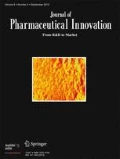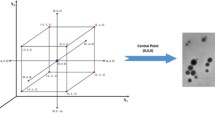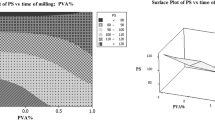Abstract
Purpose
Zoledronic acid (ZA) is one of the drugs used clinically for the treatment of osteoporosis, and its therapeutic effect is due to the inhibition of osteoclastic cells leading to bone resorption. The aim of this study is developing an optimization method for poly(lactide-co-glycolide) (PLGA) nanoparticles of ZA which is intended for local application to enable guided bone regeneration.
Methods
Three formulation parameters (ZA content, PLGA/Pluronic F68 ratio, and organic to aqueous phase ratio) were optimized to evaluate their effects on particle size (Y1), polydispersity index (PDI) (Y2), zeta potential (Y3), and entrapment efficiency (Y4) utilizing central composite experimental design (CCD). Interaction among components was studied by Fourier transform infrared (FTIR) spectroscopy, differential scanning calorimetry (DSC), and X-ray diffraction analysis. Morphology of nanoparticles was visualized with transmission electron microscopy (TEM). Stability studies of nanoparticles were also carried out for 6 months.
Results
The results revealed that formulation parameters significantly affected Y1, Y2, Y3, and Y4 of the nanoparticles. The developed quadratic model showed high correlation (R2 > 0.84) between predicted response and evaluated parameters. Spherical nanoparticles with low mean particle size (< 106.0 nm) and high encapsulation efficiency (> 39.54%) were obtained with the optimized nanoparticle formulation and maintained colloidal stability for 6 months.
Conclusions
The use of CCD for the optimization of ZA-loaded PLGA nanoparticles has provided accessibility to the formulation with optimum properties with less experimental procedure and therefore presents an important model for predicting the properties of nanoparticles prepared with PLGA polymer commonly used in the field of drug delivery.





Similar content being viewed by others
References
Mohanraj VJ, Chen Y. Nanoparticles—a review. Trop J Pharm Res. 2006;5(1):561–73.
Li S, Wang A, Jiang W, Guan Z. Pharmacokinetic characteristics and anticancer effects of 5-fluorouracil loaded nanoparticles. BMC Cancer. 2008;8:103.
Langer R. Biomaterials in drug delivery and tissue engineering: one laboratory’s experience. Acc Chem Res. 2000;33:94–101.
Martins C, Sousa F, Araujo F, Sarmento B. Functionalizing PLGA and PLGA derivatives for drug delivery and tissue regeneration applications. Adv Healthc Mater. 2018;7:1.
Mir M, Ahmed N, Rehman AU. Recent applications of PLGA based nanostructures in drug delivery. Colloids Surf B Biointerfaces. 2017;159:217–31.
Kucukturkmen B, Devrim B, Saka OM, Yilmaz S, Arsoy T, Bozkir A. Co-delivery of pemetrexed and miR-21 antisense oligonucleotide by lipid-polymer hybrid nanoparticles and effects on glioblastoma cells. Drug Dev Ind Pharm. 2017;43(1):12–21.
Lee D, Heo DN, Kim HJ, Ko WK, Lee SJ, Heo M, et al. Inhibition of osteoclast differentiation and bone resorption by bisphosphonate-conjugated gold nanoparticles. Sci Rep. 2016;6:27336.
Teotia AK, Gupta A, Raina DB, Lidgren L, Kumar A. Gelatin-modified bone substitute with bioactive molecules enhance cellular interactions and bone regeneration. ACS Appl Mater Interfaces. 2016;8(17):10775–87.
Buser D, Dula K, Belser U, Hirt HP, Berthold H. Localized ridge augmentation using guided bone regeneration. 1. Surgical procedure in the maxilla. Int J Periodontics Restorative Dent. 1993;13(1):29–45.
Watzinger F, Luksch J, Millesi W, Schopper C, Neugebauer J, Moser D, et al. Guided bone regeneration with titanium membranes: a clinical study. Br J Oral Maxillofac Surg. 2000;38(4):312–5.
Bozkir A, Saka OM. Formulation and investigation of 5-FU nanoparticles with factorial design-based studies. Farmaco. 2005;60(10):840–6.
Fessi H, Puisieux F, Devissaguet JP, Ammoury N, Benita S. Nanocapsule formation by interfacial polymer deposition following solvent displacement. Int J Pharm. 1989;55:R1–4.
Sah AK, Suresh PK, Verma VK. PLGA nanoparticles for ocular delivery of loteprednol etabonate: a corneal penetration study. Artif Cells Nanomed Biotechnol. 2017;45(6):1156–64.
Ali H, Weigmann B, Collnot EM, Khan SA, Windbergs M, Lehr CM. Budesonide loaded PLGA nanoparticles for targeting the inflamed intestinal mucosa- pharmaceutical characterization and fluorescence imaging. Pharm Res. 2016;33(5):1085–92.
Badran MM, Alomrani AH, Harisa GI, Ashour AE, Kumar A, Yassin AE. Novel docetaxel chitosan-coated PLGA/PCL nanoparticles with magnified cytotoxicity and bioavailability. Biomed Pharmacother. 2018;106:1461–8.
Akl MA, Kartal-Hodzic A, Oksanen T, Ismael HR, Afouna MM, Yliperttula M, et al. Factorial design formulation optimization and in vitro characterization of curcumin-loaded PLGA nanoparticles for colon delivery. J Drug Deliv Sci Technol. 2016;32:10–20.
Musumeci T, Ventura CA, Giannone I, Ruozi B, Montenegro L, Pignatello R, et al. PLA/PLGA nanoparticles for sustained release of docetaxel. Int J Pharm. 2006;325(1–2):172–9.
Sun SB, Liu P, Shao FM, Miao QL. Formulation and evaluation of PLGA nanoparticles loaded capecitabine for prostate cancer. Int J Clin Exp Med. 2015;8(10):19670–81.
Bohrey S, Chourasiya V, Pandey A. Polymeric nanoparticles containing diazepam: preparation, optimization, characterization, in-vitro drug release and release kinetic study. Nano Convergence. 2016;3(3):1–7.
Chen Z, Liu D, Wang J, Wu L, Li W, Chen J, et al. Development of nanoparticles-in-microparticles system for improved local retention after intra-articular injection. Drug Deliv. 2014;21:342–50.
Al-Tahami K. Preparation, characterization, and in vitro release of ketoprofen loaded alginate microspheres. Int J App Pharm. 2014;6:4–7.
Kalaria DR, Sharma G, Beniwal V, Ravi Kumar MNV. Design of biodegradable nanoparticles for oral delivery of doxorubicin: ın vivo pharmacokinetics and toxicity studies in rats. Pharm Res. 2009;26(3):492–501.
Kola Srinivas NS, Verma R, Pai Kulyadi G, Kumar L. A quality by design approach on polymeric nanocarrier delivery of gefitinib: formulation, in vitro, and in vivo characterization. Int J Nanomedicine. 2016;12:15–28.
Ali H, Singh SK. Preparation and characterization of solid lipid nanoparticles of furosemide using quality by design. 2018;36(6):695–709.
Gindy ME, Panagiotopoulos AZ, Prud'homme RK. Composite block copolymer stabilized nanoparticles simultaneous encapsulation of organic actives and inorganic nanostructures. Langmuir. 2008;24:83–90.
Turk CT, Oz UC, Serim TM, Hascicek C. Formulation and optimization of nonionic surfactants emulsified nimesulide-loaded PLGA-based nanoparticles by design of experiments. AAPS PharmSciTech. 2014;15(1):161–76.
Su R, Yang L, Wang Y, Yu S, Guo Y, Deng J, et al. Formulation, development, and optimization of a novel octyldodecanol-based nanoemulsion for transdermal delivery of ceramide IIIB. Int J Nanomedicine. 2017;12:5203–21.
Celia C, Cosco D, Paolino D, Fresta M. Nanoparticulate devices for brain drug delivery. Med Res Rev. 2011;31(5):716–56.
Xie S, Zhu L, Dong Z, Wang X, Wang Y, Li X, et al. Preparation, characterization and pharmacokinetics of enrofloxacin-loaded solid lipid nanoparticles: influences of fatty acids. Colloids Surfaces B Biointerfaces. 2011;83(2):382–7.
Olejnik C, Falgayrac G, During A, Cortet B, Penel G. Doses effects of zoledronic acid on mineral apatite and collagen quality of newly-formed bone in the rat's calvaria defect. Bone. 2016;89:32–9.
Wang F, Chen L, Jiang S, He J, Zhang X, Peng J, et al. Optimization of methazolamide-loaded solid lipid nanoparticles for ophthalmic delivery using Box-Behnken design. J Liposome Res. 2014;24(3):171–81.
Ahmed TA, Aljaeid BM. A potential in situ gel formulation loaded with novel fabricated poly (lactide-co-glycolide) nanoparticles for enhancing and sustaining the ophthalmic delivery of ketoconazole. Int J Nanomedicine. 2017;12:1863–75.
Khajuria DK, Razdan R, Mahapatra DR. Development, in vitro and in vivo characterization of zoledronic acid functionalized hydroxyapatite nanoparticle based formulation for treatment of osteoporosis in animal model. Eur J Pharm Sci. 2015;66:173–83.
Wang Y, Li P, Kong L. Chitosan-modified PLGA nanoparticles with versatile surface for improved drug delivery. AAPS PharmSciTech. 2013;14(2):585–92.
Aronhime J, Lifshitz-Liron R. Zoledronic acid crystal forms, zoledronate sodium salt crystal forms, amorphous zoledronate sodium salt, and processes for their preparation. EP1567533B1. 2009.
Alimohammadi S, Salehi R, Amini N, Davaran S. Synthesis and physicochemical characterization of biodegradable PLGA-based magnetic nanoparticles containing amoxicilin. Bull Kor Chem Soc. 2012; 33 (10): 3225–3232.
Wang L, Hao Y, Li H, Zhao Y, Meng D, Li D, et al. Co-delivery of doxorubicin and siRNA for glioma therapy by a brain targeting system: angiopep-2-modified poly (lactic-co-glycolic acid) nanoparticles. J Drug Target. 2015;23(9):832–46.
Yadav AK, Mishra P, Mishra AK, Mishra P, Jain S, Agrawal GP. Development and characterization of hyaluronic acid-anchored PLGA nanoparticulate carriers of doxorubicin. Nanomedicine. 2007;3(4):246–57.
Funding
This research is funded by the Turkish Scientific and Technological Research Council (TÜBİTAK grant number 112S533).
Author information
Authors and Affiliations
Corresponding author
Rights and permissions
About this article
Cite this article
Saka, O.M., Öz, U.C., Küçüktürkmen, B. et al. Central Composite Design for Optimization of Zoledronic Acid Loaded PLGA Nanoparticles. J Pharm Innov 15, 3–14 (2020). https://doi.org/10.1007/s12247-018-9365-6
Published:
Issue Date:
DOI: https://doi.org/10.1007/s12247-018-9365-6




